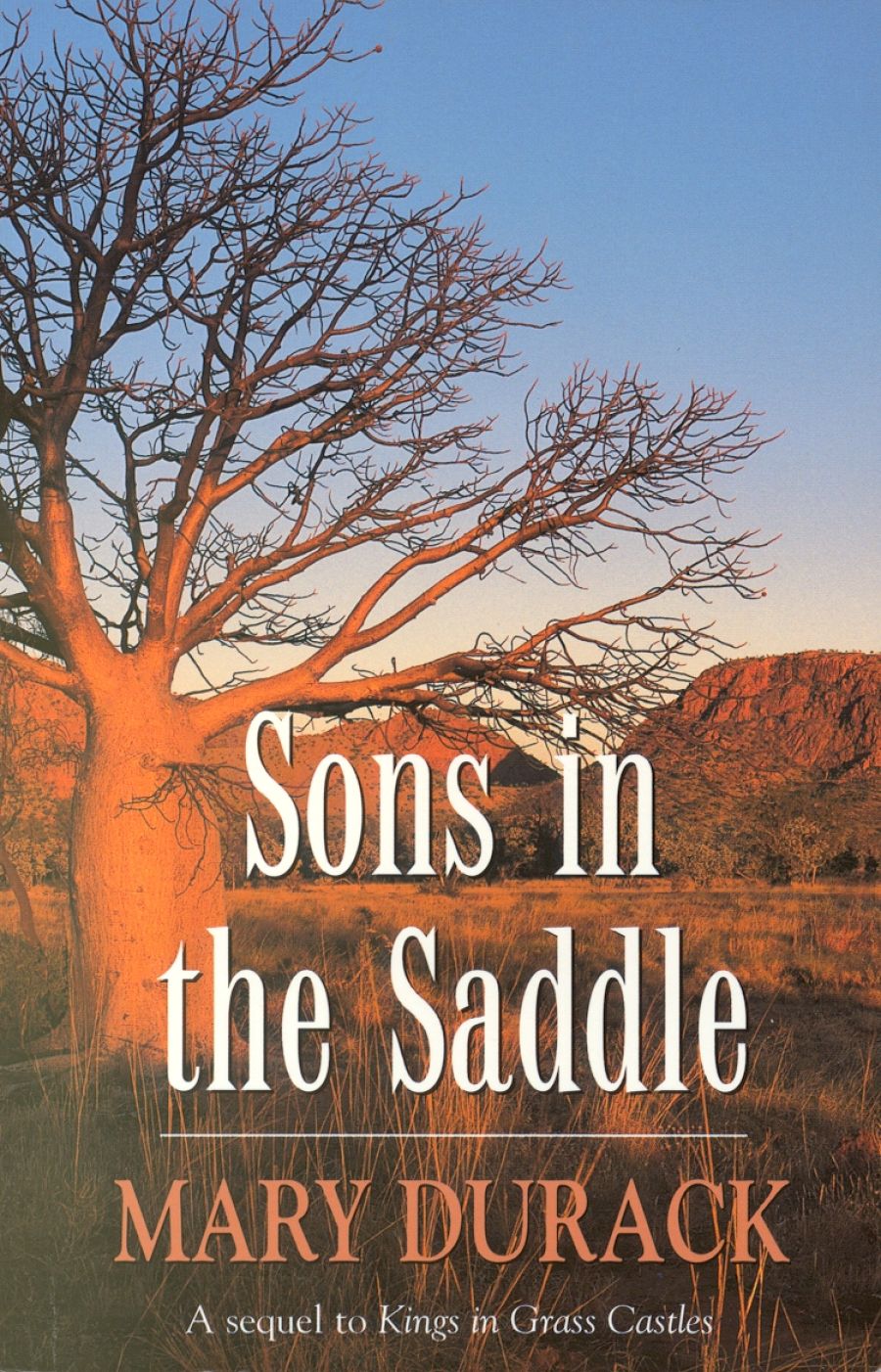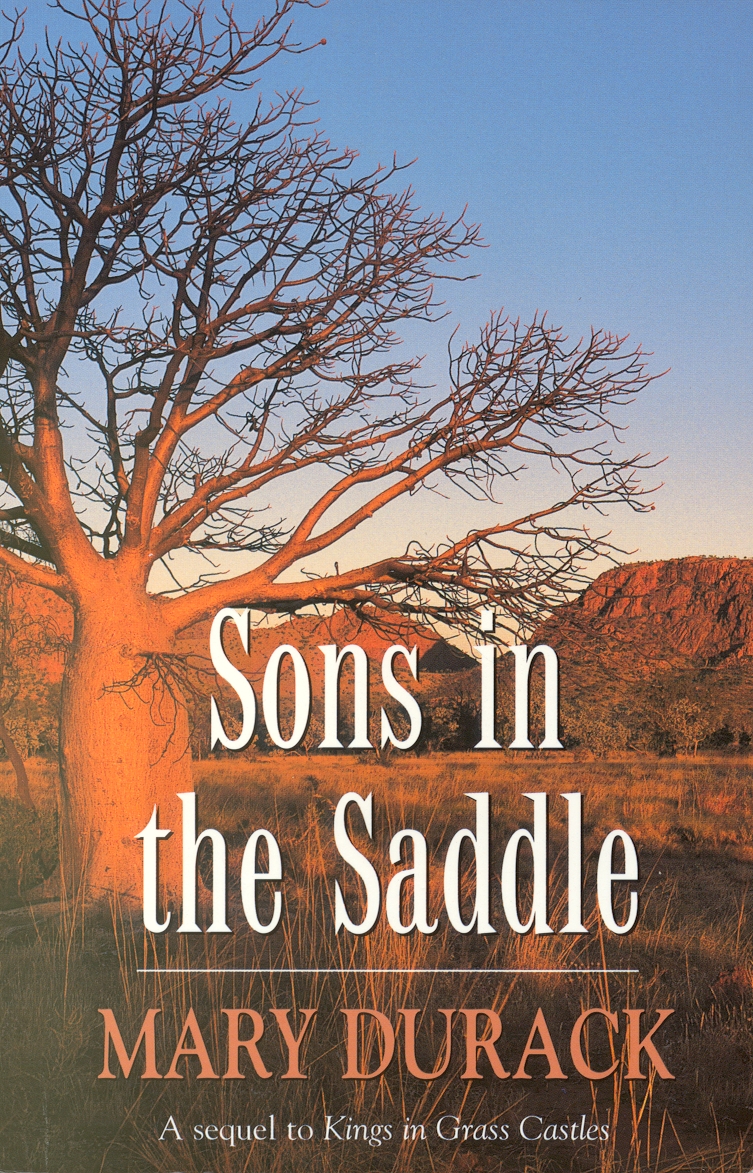
- Free Article: No
- Contents Category: Australian History
- Review Article: Yes
- Article Title: Heart-Crying My Born Country
- Online Only: No
- Custom Highlight Text:
In 1956 my husband and I lived in Perth for some months, and that is when our continuing friendship with Mary Durack; her late husband Horrie Miller, pioneer aviator, and their family, and her artist sister, Elizabeth, began. My friendship with Mary deepened over years, often at Writers’ Weeks in Adelaide, occasionally in Sydney or Perth. The various Duracks I’ve been lucky enough to know are great Australians and from them I’ve learned more about a vast country and goodness and bravery, than from almost any other people or sources. Mary is more generous than I have room to describe here, and to her a long list of Australian writers, white and black, owe debts of gratitude for help of many kinds – some acknowledged, some taken, perhaps, more for granted than it should be.
- Book 1 Title: Sons in the Saddle
- Book 1 Biblio: Hutchinson, $22.95 hb, 442 pp
- Book 1 Cover Small (400 x 600):

- Book 1 Cover (800 x 1200):

But in 1974 I had a chance to see for myself how very little for granted is the love that her Aboriginal friends accord her. Three months before Cyclone Tracey, in Darwin, she was a member of a panel conducting a workshop for Aboriginal writers jointly mounted by the Literature Board and the Aboriginal Arts Board. People attended from offshore islands, from Queensland, the Territory and Western Australia. The Western Australians knew Mary and so did many of the others.
Formal sessions were intensive and followed seriously. Everyone was trying to pack as much discussion, and giving and taking of information, into a few short days, as they possibly could. None of the discussion leaders – five or six of us – had it easy as we fielded searching questions and arguments, often about technicalities, for some of the teachers who participated were producing illustrated booklets and interested in methods and layout, while some of the people were experimenting with producing spoken material on tape – they were innovative inventors of sound effects. I wished we’d included a radio producer in the visiting group – like all of us she or he would have learned a great deal from inheritors of an oral tradition; for the ‘leaders’ it was a true time for learning.
Out of the formal sessions Mary was mobbed by affectionate people. I've heard the Duracks described as ‘Uncle Toms’ – if that was Uncle Tom-ism there should be more of it. I was also struck by, and envious of, Mary’s marvellous memory for these old friends in a hierarchic sense. I have trouble placing two or three generations of cousins in my own family. Mary unerringly remembered who were people’s grandparents, parents, aunts, uncles, cousins, children, and their tribal inter-relationships too.
This is one of the gifts that, in Sons in the Saddle, enables her to chronicle her own huge family skilfully, and with little apparent effort. She rightly acknowledges the diaries which many Duracks kept and keep, and the meticulous business and other records that they stored for posterity (and saved despite one eager tidier up); but behind all of that are people. Literal hordes of people. Duracks and their loves, their spouses, their friends, business partners and their family connections, employees, political friends and enemies, and a fascinating collection of men and women, good and villainous, who wandered into, and sometimes out of, the north west of Western Australia.
How to order all these people? How even to cope with Durack given names when over several generations they are duplicated and re-Suplicated in linked family lines? Genealogists have excellent answers for such problems, but their solutions scarcely make engrossing reading for a general audience. In Sons people live and are alive, die and are dead – some horribly, for it covers a period before air transport when the chief areas concerned were not only harsh and difficult, but remote and violent. Part of the solution is the use of initials for many family characters: (Mary’s father, the central figure, is ‘H.P.’); part is a splendid series of reference notes to each chapter – they include two of Mary’s poems. To comment on matters like good writing and historical importance is an impertinence with a book like this. Comparisons with Kings in Grass Castles are inappropriate for Sons is,
of internal necessity, a completely different kind of book from its predecessor; as Edmund Campion says (Bulletin Nov. 1, 1983), ‘Where Kings swept the reader along, Sons in the Saddle offers the stop-and-see delights of tiny detail. Events are taken up and let drop just as they occur, without the hindsight of history ... here, as in life, there are plenty of loose ends’.
There has already been comment on the honest, unsentimental and, when appropriate, affectionate writing about Aborigines in Sons. In another recent book (Banggaiyerri) Bruce Shaw in his introduction comments upon Mary Durack’s own changing and maturing written attitudes over her whole published body of work. But what interests me is that here she acknowledges at least one half-cast relative. Another pioneer Western Australian family has recently in print acknowledged several part Aboriginal family members though I did not keep the precise reference in that case.
Two swallows of this sort may not make a summer, but anyone who remembers the shamed secrecy that once surrounded convict ancestors, and the almost sudden willingness to acknowledge such forbears with pride that occurred during and after the 1950s, may wonder whether some equally refreshing air is about to enter this hitherto taboo area.
One last point: the commercial history pervading this family saga should not be overlooked. Mary’s father and other family members during the period covered, 1898-1920, travelled overseas a good deal, one of their purposes being to observe meat industries in the Americas and elsewhere and to acquaint themselves with developments in trade and technology. Whatever the future may hold the Durack saga is a sad and doomed one in some ways. The Kimberley region is still subject to the tyranny of distance and transport difficulties. The Ord River Dam that drowned Argyle Station and its homestead and perhaps rich diamond fields, has yet to find its true potential usefulness; even in a hungry world. I mentioned Dame Mary Durack’s much too infrequent poetry. In the Bulletin (Nov. 1, 1983) she spoke her ‘Lament for the drowned country’ through the mouth of ‘old Maggie, old Jilligan’ and Elizabeth illustrated the poem. Old Maggie cries her lament, but also her hope which is surely Dame Mary’s own symbolic faith which is the faith of her fathers. The long and very fine poem ends:
Little fish, you tell him – me, old Maggie, old Jilligan
heart-crying my born country. I got him here –
inside my heart, can't lose’m. I got that dream,
that message. You talk my country: Hold on!
Some time you gonna look out that sun again. You gonna
see all that moon and star. You gonna
feel that warm wind blowing.
You gonna see that sky!


Comments powered by CComment